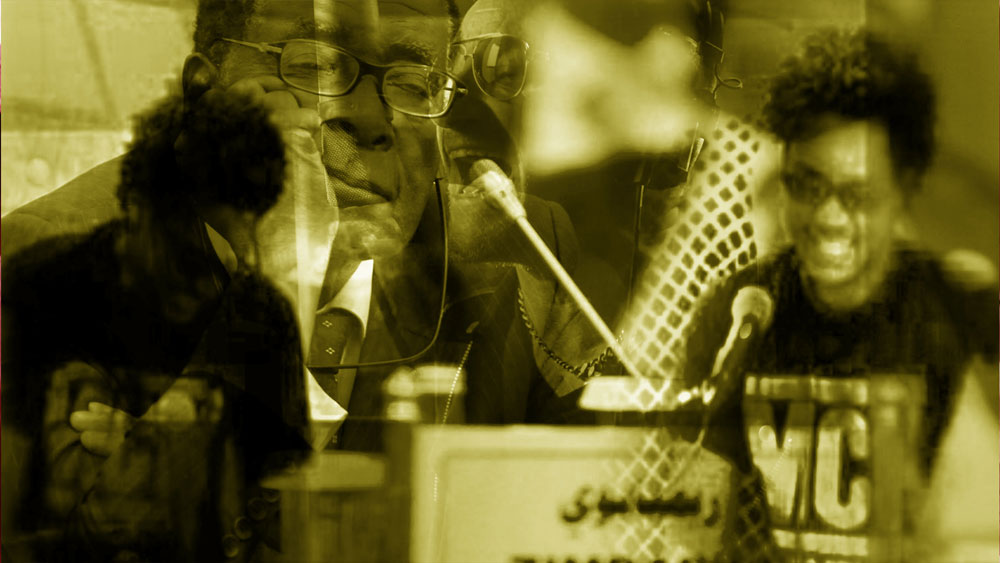Presenting Perspectives
Amongst national pavilions and collateral events that include anywhere from one to 50 artists and hundreds of artworks, Angolan-born, Belgium-based artist Nástio Mosquito’s exhibition at the 56th Venice Biennale provides breath of fresh air. With only three pieces on view in an eponymously named exhibition at the Oratorio di San Ludovico, the artist allows the viewer to spend time with and properly digest his work.
Upon walking inside the 16th-century building (which was formerly a church and is now a space for contemporary art directed by Nuova Icona), viewers are greeted by South, a work made by Nastivious—a name used to credit Mosquito and his frequent collaborator, Spanish artist Vic Pereiró. Digitally altered and animated photographs project from the ceiling onto a circular white platform in the center of the floor, and between jarring image juxtapositions, static videos show the two men sitting at a table, with a ghostly voice asking questions. Rather than showing their faces and properly addressing the questions, the video focuses on upper bodies and hand gestures as the men express eloquently worded non-answers.
With roots in the broadcast industry and no formal art training, Mosquito almost always inserts himself into his work, assuming multiple identities to present various perspectives instead of his own opinion. The two other works on view, Fuck Africa Remix (2015) and Demo de Caracía (2014), further explore this with an installation of moving images featuring the artist, world leaders, and celebrities, as well as a type of music video gone wrong—Mosquito breaks into a speech on Angola and identity mid-performance. Throughout his practice, Mosquito, who has shown work at insitutions like Tate Modern and Walker Art Center, embraces and combines video, music, performance, and installation to address the current state of the world and where we might be going.
Before the opening of his exhibit last week, we spoke with artist about preparing for the show and what, if anything, it means to show his work in Venice.
EMILY MCDERMOTT: Has it been a long day of preparations?
NASTIO MOSQUITO: It was a couple of days trying to get things right and dealing with a lack of straight angles in Venice—working with a video, that’s quite messy.
MCDERMOTT: How did you find this space? Did you know this was where you’d be exhibiting South when you made it?
MOSQUITO: Yes, I had been here before with Jonathan [Watkins, the curator]. I knew what I wanted, what my intention was, but the team that is working, the space, and the equipment all condition what you do in the end. Being from Angola, I’m used to having to make things work, in terms of not having a budget and in terms of not even having a need for your work to exist. I never produced work because somebody said, “You are so good at doing what you do. Why don’t you do something?” It was always me believing I had to do something, and because I’m not a lonely individual, because I am part of a society, I think it’s going to resound with someone. That belief takes a lot of energy—emotional energy, contemplative energy. The biggest problem [in producing work] is not the money; it’s people believing that the work should exist. If you have people supporting you and thinking that things should exist, you find a way. Fortunately enough, here and there, I was finding the legitimacy to do that, and that makes you be resourceful within, to look for solutions with what you have around you.
MCDERMOTT: What did you learn about yourself when finding these resources on your own?
MOSQUITO: I found that I can relate to people, that I can speak to people. I found that I am not alone, in the sense that my perspective is not “unique;” I have people who can relate to what I do. I also found that being “unique,” and being “the one,” it’s a very lonely place to be. I found teamwork and perseverance. I found leadership as well. I was able to say, “Believe me. Trust me.” Those are very demanding things to express to other individuals. When you express that and people do that, then you have to deliver. I found that I was available to put myself in that position. I haven’t always succeeded, but I’ve always given my best. My best changes, so I have higher and higher expectations to what I want from myself and from the people around me. It’s an ongoing process.
MCDERMOTT: Speaking about the work you made for this show—there are a lot of unanswered questions. You pose specific questions, but do not answer them. With your work in general, do you ever try to propose an answer?
MOSQUITO: I want to present perspectives, and perspectives are a broad range of questions, answers, statements, doubts, jokes, points of view. What I don’t want is to make it about my opinion. That is too limited. I want it to make it about the ideas; I want to make it about perspectives; I want to make it about possibilities; and I want to make it about edifying the need for clarity and respecting our dreams, respecting our incredible angst for better.
MCDERMOTT: What are some of your dreams?
MOSQUITO: My dream is to have an idea and to have the capacity to bring that idea to life. I want to be in a position where I can have an idea and I have the people, I have the collaborations, I have the partners, to make that idea come to be. The dream is to edify people: we can live better. My dream is to make it tangible, this thing that we’ve lost respect for, which is to look to another individual and say, “Your dream matters. Your dream is possible. If you are dreaming it and if it is connected to who you are, and if it is somewhat connected to your sense of fulfillment, to your sense of purpose, to your sense of direction, it’s worth it. Move your ass. Stand up. Believe in it. Go travel. Go find your clue, find the ones who believe it is worth it.” So my dream is to be in that position, to be a contributor for that level of energy in people’s lives.
MCDERMOTT: How do you think showing the work in Venice, at this specific location, opposed to showing it in a museum might change the meaning?
MOSQUITO: I don’t give a fuck. That’s not my concern. My concern is to optimize the experience. I’m concerned with people getting into the space and having an experience, having to engage with it—for our choices to be present and to engage with you, to be a conversation, for you to complete the work with your own perspective. And, to some extent, it doesn’t matter where it is. It’s always going to be different. For me, it’s always an opportunity to have a conversation.
MCDERMOTT: Where did the idea come from for South?
MOSQUITO: I’m not originally from the art world and didn’t study fine arts, so it comes from this articulation, this place where I don’t want to make this shit about irony. I don’t want to make shit about sarcasm. It’s an homage to all the popular culture references that we have, but it’s also to say just because I think that Pollock was the shit, doesn’t mean that I cannot fuck with him, doesn’t mean that I cannot remix him in the name of a perspective, in the name of position.
It was also recognizing that I am somewhat part of this visual arts family. This is where I make my living, this is where I have the opportunity to interact with people. It was not my intention, [but] I am here now and I have as many questions and I run into as many contradictions as the rest of us. It’s never my intention to explain the work. I’ll let you engage with it, what it translates to you, but it does have different layers. It’s also to open space, to create space, so we have space to work and to make sure people stop asking us what, in our perspective, are redundant questions. We ask those questions ourselves, and our answers are there, which are, in many aspects, the lack of answers. So let’s move on.
MCDERMOTT: Bringing up Vic, what originally drew you to working with him? I know you collaborate frequently.
MOSQUITO: If I speak about the flavor, or about a sensation, normally Vic has the capacity to translate that into something tangible and that’s priceless. So we have a very empathic relationship. We don’t discuss too much. We don’t argue too much. We just engage with each other. He challenged me one day to do something, for me to initiate something that would continue, so we started Nastivicious from there. Then we understood that we shared something in common: we want to make people feel good about themselves and their dreams and we are not afraid to expose ourselves in the process, expose our limitations, be it technical or cognitive—to put ourselves out there to say it is possible. We are firm believers in tough love as well. We are tough believers that clichés have a reason as to why they are clichés and we want to reignite some of these things in the people we share everyday life with.
MCDERMOTT: How did you select the other two works you wanted show?
MOSQUITO: It was a combination of conversations with Jonathan and what would be relevant for me to bring here. The fact that we bring, in some way, songs to a place of art, it’s an engagement with popular culture. I never do take myself too seriously, but in this context, I think I provide a refreshing experience. None of them were made on purpose for here, [where] you see political statements, aesthetical statements. It felt like what I wanted to do here, was for people to have fun and still take something with them. It just made sense. It expresses my attitude. I think there’s a fourth work, which is the space itself. I’m very happy with the solutions we managed to find with the space. I hope we can touch people.
“NASTIO MOSQUITO” IS PRESENTED BY IKON AND NUOVA ICONA AS AN OFFICIAL COLLATERAL EVENT OF THE 56TH VENICE BIENNALE. THE EXHIBIT IS ON VIEW THROUGH JULY 26.
For more from the 56th Venice Biennale, click here.







